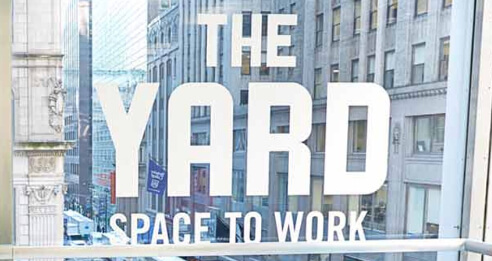
Largest Coworking Companies


This is a guest post from our technology partner Optix, a coworking management software that helps flexible workspace operators manage, measure, and grow their business.
You’ll often hear the expression, “every company is a tech company.”
It means that in our digital-first world, every company needs to be technologically-savvy and up-to-date with the technology they deploy…including coworking spaces.
As a coworking technology platform, we’ve seen firsthand the power that the right tools can have on helping a flexible workspace reach its fullest potential. But how do you create an effective technology ecosystem that gets the job done, without overcomplicating things?
In this guide, we’ll show you how to create a coworking technology stack that is efficient, effective, and fully integrated into your day-to-day operations.

As a coworking operator, you’re wearing many hats at a time. Technology is the secret to extending your own abilities as an operator, while making the operations of your space more efficient.
The biggest benefits we see to implementing technology in a coworking space are:
It’s easy to feel like you need every platform imaginable when you’re just starting out. However, we always suggest starting light with the essentials and building out from there.
This will help save you a tremendous amount of time and money by not overcomplicating things right from the beginning.
Below are the four tools we recommend every coworking space start with.

What it is: Coworking software handles all of the day-to-day operations of your business in addition to providing a tool for your members to interact with. Think of it as the heart of your coworking tech stack.
Why it’s important: If you’re going to invest in one piece of technology, coworking software will get you the most bang for your buck. It’s essential to creating operational efficiency in your space and can also support in elevating your user experience.
How it can benefit you:
What it is: A payment gateway is a software that takes payment information from your members, facilitates transactions, and disperses the money to your bank account.
Why it’s important: Being able to accept credit cards and other digital payment methods is a must in every coworking space. A payment gateway enables you to do so.
How it can benefit you:
What it is: Accounting software is an online, typically cloud-based, platform that helps coworking businesses automate their day-to-day financial operations.
Why it’s important: Revenue is the backbone of your coworking business. You need to have a deep understanding of your finances in order to run a successful space.
How it can benefit you:
What it is: A door access control system is an online, cloud-based platform that helps manage access to your space.
Why it’s important: Automating access to your space will not only enhance your security, but also ensure your space is accessible if and when you need it to be.
How it can benefit you:
Technology is a must in the modern coworking space, but it’s not enough just to have it. The real value lies in building an integrated ecosystem of tools that communicate with one another seamlessly.

Most operators quickly find out having five tools that don’t talk to each other creates more work than having just one. That’s why having an integrated tech stack is key.
There are two elements of integration that are important to consider:
Integrating your tools with one another refers to the technical side of integrating your various technology platforms.
Let’s say you are using Kisi to manage access to your space, Xero to do all of your bookkeeping, Stripe as your payment processor, and Optix for your coworking software.
Once you integrate these tools with one another (which is often as simple as copying and pasting a piece of code or clicking a couple of buttons), then they will share data with one another.
All of this is done without you needing to think about it.
Integrating your tools into your operations is a less talked about, but equally important, part of building a tech stack.
Introducing new tools into your space doesn’t necessarily mean that your team and your members are going to start using them. There are often significant challenges with the adoption of new technology, especially if it’s radically different from what you were doing before.
That’s why it’s important to think about how a tool will fit into your operations and your business during the evaluation process. Consider the following questions:
Below we’ll walk you through how to create an integrated tech stack: one that fits in with your current operations and is designed to work with the tools you already have.

Are you looking to add some technology to your toolkit? Wondering if you have the right platforms in place right now?
Use this framework to help you build the right tech stack to meet your coworking space where it’s at.
Before you start to add any new piece of technology into your ecosystem, ask yourself, what problem am I trying to solve? And what do I need my technology to accomplish for me?
Adding tech to your toolkit because you think you should is a surefire way to build an overcomplicated and ineffective system. Instead, make a list of your biggest operational challenges and see what you can implement to address them.
The problems we frequently hear about include:
If you already have some technology set up in your space and you’re still having issues with your operations, then make a note of those too. Having an understanding of these issues can help you know when is the right time to start thinking about switching your software.
Once you’ve figured out what problems you need to solve, then you’ll need to think about what software you’ll use to address them.
Evaluating software can be a headache, especially if you’re not familiar with the systems or what they do. While it’s easy to get caught up in the bells and whistles (or just use what other people are using) the most important thing you can do while evaluating your options is keep your unique business needs top of mind.
Think about things like:
Your software is an extension of your business. Choose ones that will work with you and help elevate your brand well.
After you get set up with all of the tools you need, the next step is integrating them with one another.
Luckily, this is one of the easiest parts of the process. Most software companies make integrations relatively seamless. You’ll follow their specific documentation and guidelines provided and voila! You have an integration.
There may be some simple troubleshooting and testing involved to make sure it’s working as properly. Take the steps necessary to test your integration before introducing them to your team or members.
The final step in creating a fully integrated technology system is informing your members (and your team!) on how they work and how to use them in your space.
A proper onboarding process will increase the adoption of the tools, therefore increasing their overall effectiveness.
The most successful operators have a plan for tool adoption that goes beyond just implementing it in their space. This includes things like:
It’s always best practice to educate your members and introduce these tools as soon as new members join. Offering as much information as you can during onboarding can help ensure your members are well educated and can act autonomously in your space.
Implementing the right tools and technology into your space will truly take your business to the next level.
Start lean and get the essentials. Integrate them with one another. Develop a robust plan to ensure it is adopted into your member’s daily routine.
This is how you ensure you get the most out of the tools you’re using.
Curious to learn more about coworking technology? Schedule a call with Optix to see how you can grow your business with the right tools.
Save your community manager 41 hours each week—learn how The Yard did it with cloud-based access control.
Read the Case StudyFree access to our best guides, industry insights and more.
